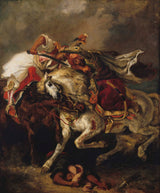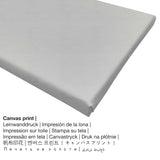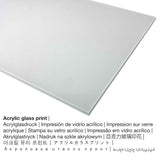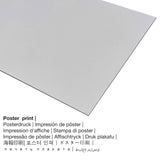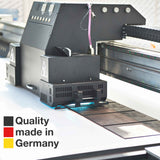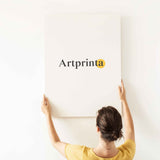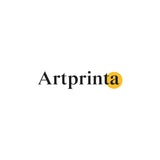Eugène Delacroix, 1835 - Il combattimento del Giaour e del Pascià - stampa fine art
Tasse incluse. Spedizione calcolata alla cassa.
L'offerta del prodotto
Questo più di 180 capolavoro vecchio di anni è stato dipinto dal maschio pittore Eugène Delacroix. The original has the following size: Height: 73 cm, Width: 61 cm. Oil painting was used by the French artist as the medium of the artwork. The original masterpiece has the following text as inscrption: Date and signature - Signed and dated lower right: "Eug 1835 Delacroix.". Al giorno d'oggi, l'opera d'arte appartiene alla collezione d'arte digitale di Petit Palais - Musée des Beaux-Arts de la Ville de Paris, che è un museo d'arte nell'8 ° arrondissement. Il arte moderna opera d'arte, che fa parte del dominio pubblico è incluso con la cortesia di Petit Palais ParigiLa linea di credito dell'opera d'arte è la seguente:. Inoltre, l'allineamento è ritratto con un rapporto immagine di 1: 1.2, il che implica questo la lunghezza è del 20% più corta della larghezza. The painter Eugène Delacroix was an artist, whose art style can be classified as Romanticism. The European artist was born in the year 1798 a Saint-Maurice, Val-de-Marne e morì all'età di 65 nell'anno 1863 a Parigi.
Quale sarebbe il tuo materiale di stampa fine art preferito?
Per ogni stampa artistica offriamo diversi materiali e dimensioni. Scegli ora tra le seguenti opzioni di prodotto per soddisfare le tue preferenze in termini di dimensioni e materiale:
- Stampa su vetro acrilico: The acrylic glass print, often described as a fine art print on plexiglass, makes the original into lovely décor. Further, the acrylic art print makes a good alternative option to canvas or aluminium dibond art prints. Your favorite work of art will be manufactured with the help of modern UV printing technology. The major upside of an acrylic glass art print is that contrasts plus smaller image details will be recognizeable due to the precise tonal gradation.
- Stampa dibond in alluminio: An Aluminium Dibond print is a material with a true depth. The bright & white parts of the work of art shimmer with a silk gloss, however without glow. Colors are luminous in the highest definition, fine details are crisp, and there’s a matte appearance that you can literally feel.
- Stampa di poster (materiale tela): Our poster print is a UV printed canvas paper with a fine surface finish. Please bear in mind, that depending on the absolute size of the canvas poster print we add a white margin 2-6cm around the print, which facilitates the framing.
- Stampa su tela: The printed canvas material mounted on a wood stretcher frame. Hanging a canvas print: A canvas print has the great advantage of being relatively low in weight, which implies that it is easy and straightforward to hang up the Canvas print without additional wall-mounts. A canvas print is suited for all types of walls.
Legal note: We do our best in order to describe our products as exact as we can and to display them visually in our shop. Still, the pigments of the printing material and the imprint can diverge somehwat from the representation on the device's screen. Depending on your settings of your screen and the nature of the surface, colors may not be printed as exactly as the digital version on this website. In view of the fact that all art reproductions are printed and processed manually, there might as well be minor differences in the exact position and the size of the motif.
Informazioni sugli oggetti strutturati
| Classificazione dell'articolo: | stampa d'arte |
| Riproduzione: | riproduzione digitale |
| Tecnica di produzione: | Stampa diretta UV (stampa digitale) |
| Provenienza: | Produzione tedesca |
| Tipo di scorta: | produzione su richiesta |
| Destinazione d'uso del prodotto: | design per la casa, galleria da parete |
| Orientamento: | allineamento verticale |
| Rapporto immagine: | 1: 1.2 |
| Interpretazione del rapporto immagine: | la lunghezza è del 20% più corta della larghezza |
| Tessuti prodotto disponibili: | stampa su metallo (dibond in alluminio), stampa su vetro acrilico (con rivestimento in vero vetro), stampa su poster (carta tela), stampa su tela |
| Opzioni di formato della stampa su tela (tela su telaio della barella): | 50 x 60 cm - 20 x 24 ", 100 x 120 cm - 39 x 47", 150 x 180 cm - 59 x 71 " |
| Varianti di formato della stampa su vetro acrilico (con rivestimento in vero vetro): | 50 x 60 cm - 20 x 24 ", 100 x 120 cm - 39 x 47", 150 x 180 cm - 59 x 71 " |
| Opzioni di stampa poster (carta tela): | 50 x 60 cm - 20 x 24 ", 100 x 120 cm - 39 x 47" |
| Stampa su alluminio (materiale dibond alluminio): | 50 x 60 cm - 20 x 24 ", 100 x 120 cm - 39 x 47" |
| Cornice: | Senza cornice |
Dettagli delle opere strutturate
| Titolo dell'opera d'arte: | "The Combat of the Giaour and the Pasha" |
| Classificazione dell'opera d'arte: | pittura |
| Termine generale: | arte moderna |
| Periodo: | 19th secolo |
| Anno di creazione: | 1835 |
| Età dell'opera d'arte: | oltre 180 anni |
| Mezzo originale dell'opera d'arte: | Pittura ad olio |
| Dimensioni originali (grafica): | Altezza: 73 cm, Larghezza: 61 cm |
| Firma sull'opera: | Date and signature - Signed and dated lower right: "Eug 1835 Delacroix." |
| Museo / luogo: | Petit Palais - Musée des Beaux-Arts de la Ville de Paris |
| Luogo del museo: | Parigi, Francia |
| Sito web del museo: | Petit Palais - Musée des Beaux-Arts de la Ville de Paris |
| Licenza dell'opera d'arte: | dominio pubblico |
| Per gentile concessione di: | Petit Palais Parigi |
Informazioni sull'artista
| Nome dell'artista: | Eugène Delacroix |
| Genere: | maschio |
| Nazionalità dell'artista: | Francese |
| professioni: | pittore |
| Paese dell'artista: | Francia |
| Classificazione: | artista moderno |
| Stili d'arte: | Romanticismo |
| Età alla morte: | 65 anni |
| Anno di nascita: | 1798 |
| Città: | Saint-Maurice, Valle della Marna |
| Morto: | 1863 |
| Deceduto a (luogo): | Parigi |
Questo testo è proprietà intellettuale e protetto da copyright ©, Artprinta.com
Original artwork information from Petit Palais - Musée des Beaux-arts de la Ville de Paris website (© Copyright - Petit Palais - Musée des Beaux-arts de la Ville de Paris - Petit Palais - Musée des Beaux-Arts de la Ville de Paris)
Inspired by oriental Lord Byron poem, the painting represents the decisive battle between the Giaour, mounted on a black horse, and Hassan Pasha, on his white horse. The Giaour, standing over his saddle, hard with a wild smile cloth covering the chest of the Pasha to reach the heart with acute blade of his sword. The pasha, precariously balanced on his horse, holding in his right hand a dagger, trying to push her attacker on the other hand. The ferocity of the struggle is also expressed in the attitude of the horse, the black horse biting the chest white horse, already wounded in the thigh. The latter seems to be reluctant to walk on the dead body of a Muslim lying on the ground. For Delacroix, the subject is mostly an excuse to portray a melee of great intensity, where humans and animals are closely associated.
Figure guardian of Romanticism, Delacroix was introduced to the East by reading Byron works. He discovers the realities during a trip to Morocco in 1832. His style of painting is deeply marked by the experience. This painting was inspired by a passage from Byron oriental tales published in 1814 under the title "The Giaour, a fragment of a turkish tale". The story chronicles the thwarted loves of a Venetian, the Giaour (term for an infidel to Muslims) and a slave, Leila, belonging to the harem of Hassan, military chief of a Turkish province. Leila, who missed the loyalty she had the Pasha Hassan was thrown into the sea. Her lover, the Giaour, the revenge by killing Hassan.
Hassan Pasha (literary character); The Giaour (literary character)
Scene, Single combat, Knight, Pasha, Turkish, Turban, Horse, Saber, Dead, Orientalism

